The world is full of different breeds of horses. Between the largest horse and the smallest, there is almost a 15-hand difference in height (measured from the highest point of the withers)! This article will focus on the biggest horses, so here is a list of the world’s largest horse breeds and information about them.
| Large breed | Height in hand (upper average heigt) | Weight in pounds (upper avarage weight) |
|---|---|---|
| Percheron horse | 19 | 2600 |
| Belgian draft horse | 18 | 2400 |
| Clydesdale horses | 18 | 2200 |
| Boulonnais horse | 17,3 | 2000 |
| Australian draught horse | 17,2 | 2000 |
| Shire breed | 17,1 | 2400 |
| Suffolk punch horse | 17 | 2200 |
| Soviet Heavy Draft | 16,3 | 2200 |
| American cream draft horse | 16,3 | 2000 |
| Međimurje horse | 16,1 | 2000 |
| Ardennes | 16 | 2200 |
| Breton horse | 16 | 2095 |
| Lithuanian Heavy Draught | 16 | 2028 |
| Schleswig Coldblood | 15,3 | 1800 |
| Dutch draft horse | 15,3 | 1653 |
| Jutland horse | 15,3 | 2200 |
| Rhenish German Coldblood | 15,3 | 2200 |
| The Italian Heavy Draft | 15,3 | 1540 |
| North Swedish Horse | 15,3 | 1540 |
| Comtois horse | 15,1 | 1760 |
| Russian heavy draft horse | 15 | 1550 |
These largest breeds of horses belong to draft horses developed for heavy work as draft animals (pulling heavy weight for long distances) for both agricultural and industrial work. The typical draft horse is a muscular horse with an impressive size and a calm and stable temperament which makes them loved by horse enthusiasts. Draft horses are large horse breeds both according to the average height measured at the point of the withers and average weight and are the strongest horse breeds existing.
Percheron Horse
Height: from 15 to 19 hands
Weight: up to 2600 pounds with an average of around 1900
The breed originates from and takes its name from the province of Le Perche, southwest of Paris in France. It was a popular breed in the U.S. during the 1880s and nearly 5000 stallions were imported from France. The breed is characterized by being proud, alert, intelligent, and willing to work. The most common colors of Percherons are black and grey. They can have white markings but should not have too much white. The Percheron is of course used as a draught horse, also for pulling light wagons, riding, and even jumping. There is a use for the breed in modern forestry, where the horse can get around without damaging the land in areas where tractors and forestry machines cannot.
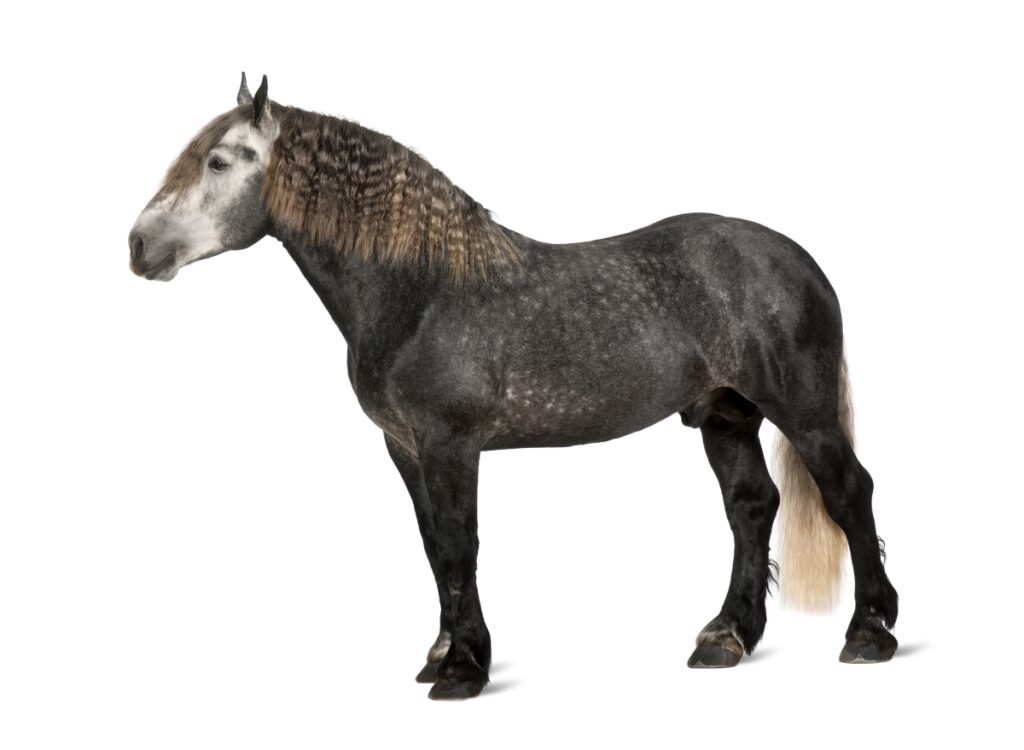
Dr. LeGear was a big famous Percheron horse. In 1903 he claimed the title of the biggest horse in the world with his 21 hands and weight of 2,995 pounds.
Belgian Draft Horse
Height: 16 – 18 hands (about 6 feet or 1.80 meters)
Weight: 1800 – 2400 pounds (800 – 1100 kilograms)
Belgian Draft Horses are by far the most popular and most common draft breed in the United States and a breed of very large size. The breed originated in Europe, Belgium. Historically, Belgian draft horses have roots in the “Great Horse” from the Middle Ages. Originally these Belgian horses were used in war but were then developed to work as farm horses. Originally the horses from Belgium had many different colors but in the U.S., breeding on sorrels and roans in particular has become popular. White markings on the face and legs are common.

Photo: “Radar – Belgian Draft Horse” by Just chaos is licensed under CC BY 2.0.
Until June 2021, when he died, Big Jake was the world’s tallest living horse according to the Guinness World Records book. He was a Belgic draft from Wisconsin USA who was 20 hands 2.75 in (210.19 cm, 82.75 in) tall. This you could call a large size!
Clydesdale Horses
Height: 17 – 18 hands
Weight: 1500-2200 pounds (700–1000 kg)
The Clydesdale horse originates from Scotland and is a native breed from Lanarkshire (previously called Clydesdale or valley of the River Clyde). The breed dates from the mid-18th century. This heavy horse was very popular in the early 1900s but then declined drastically to be classified by the Rare Breed Survival Trust as “vulnerable” in 1975. Now the Clydesdales have increased slightly in numbers but are still at risk. The breed is known for its voluminous and soft feathers on the lower legs. Nowadays the Clydesdale is used for driving, forestry, and agricultural work but also for pleasure riding. There are now several shows where Clydesdales are shown both by hand and ridden. For most people, they are probably best known as the big horses from the Budweiser commercials – the Budweiser Clydesdales.

Photo: “Richmond Flying Squirrels vs. Erie SeaWolves” by Gamma Man is licensed under CC BY 2.0.
King LeGear was a massive-sized Clydesdale, by the age of 7 he was 20.5 hands high and a weight of 2950 pounds.
Boulonnais Horse
Height 15.1 -17.3 hands
Weight 1300-2000 pounds (600 and 900kg)
The Boulonnais breed originated in northern France in 1886 and was very common in the early 20th century (more than 600,000 horses in France). But then the Boulonnais almost died out during the two world wars. Today only about 700 horses remain in France and only a few in the U.S. The horses are usually grey only 15% deviate and are of a different color (mainly chestnut, occasionally black). The horse is therefore called the “White Marble Horse”. Used mainly for driving both heavier missions but also lighter precision driving and competition. There are two different types of Boulonnais, a heavier variety and a lighter variety called Mareyeur.
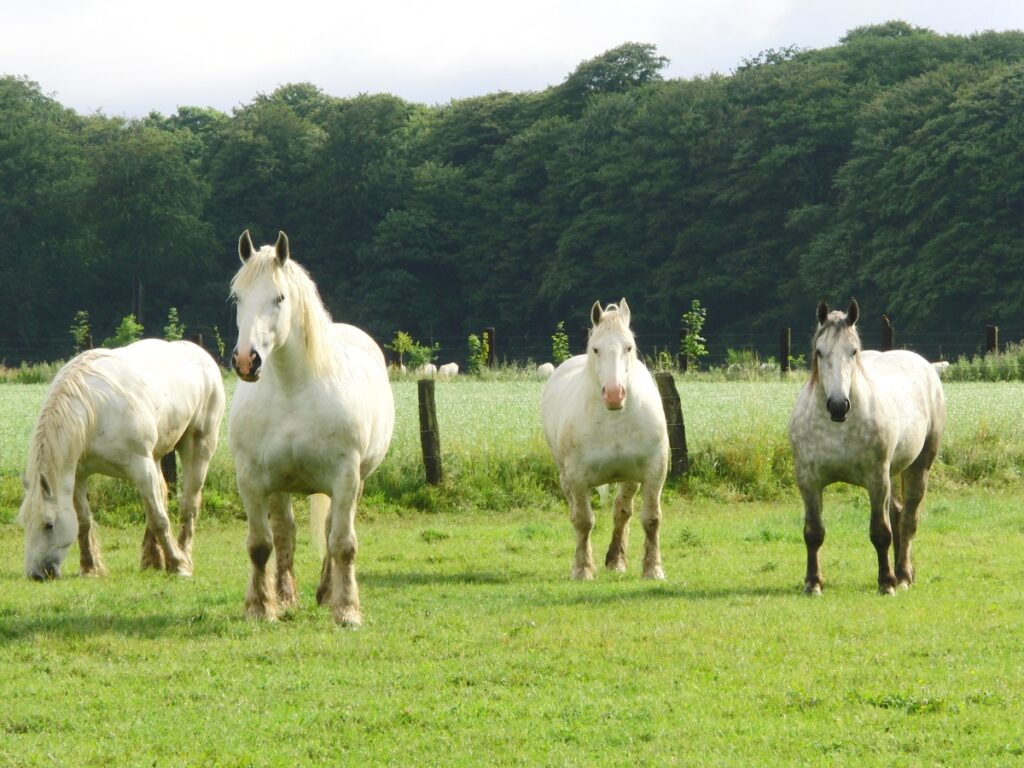
Photo: “File:Chevaux boulonnais.JPG” by Eponimm is licensed under CC BY-SA 3.0.
Australian Draught Horse
Height: 16 – 17.2 hands
Weight: 1300-2000 pounds (600 and 900kg)
The Australian draft horse is historically bred by crossing the draft horses that existed in the country with the Clydesdale, the Percheron, the Suffolk, and the Shire. In 1979, the Australian Draught Horse Stud Book Society was formed and the Australian Draught Horse was officially a breed in its own right. The large horses are currently used in plowing competitions and shows. In forestry, the horse still has an important use. Horses of this breed can have all solid colors, it is not desirable with too many and large white markings.
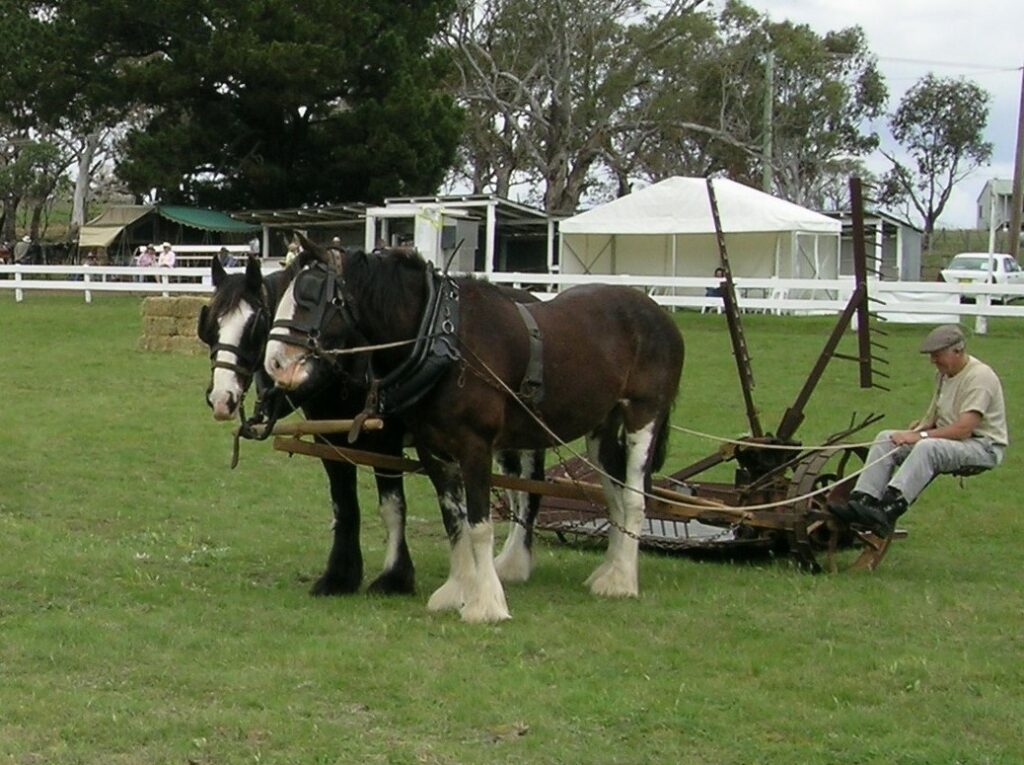
Photo: “File:Aust Draught Horses.JPG” by Cgoodwin is licensed under CC BY-SA 3.0.
Shire Horse
Height: Minimum 16.2 hands and upwards. Average 17.1 hands.
Weight: 1800-2400 pounds (850kg – 1100kg)
These gentle giants derived from the “English Great Horse” from the Middle Ages. The horse was originally used in agriculture and to transport goods in England. Today they are popular in horse shows and are still used to pull the carriages of brewers on city streets. They are also still used in agriculture on small farms and also in forestry. Shire horses also take part in competitions such as skills tests and obstacle driving, plus cross-country trials. In the world today there are about 3000 Shire horses registered in the American Shire Horse Association. They come in various colors and the most common colors are bay, black, brown, grey, and more rarely chestnut. Too many white markings or roaning is not preferable.

According to the Guinness Book of World Records, the tallest and heaviest horse of all time is a Shire gelding born in 1846 named Sampson (later Mammoth) in Great Britain. He was 21.2½ hands (2.19 m) as an adult weighing 3,359 lb (1524 kg). According to this information, the Shire horse is the tallest horse breed in the world and also the world’s largest horse breed according to weight.
Suffolk Punch Horse
Height: 15,3 – 17 hands
Weight 2000 to 2200 lb
Many draft horses are descended from medieval war horses, but the Suffolk Punch Horse was developed by rural farmers in the east of England to manage heavy farm work. They bred a horse to plow the heavy clay soil and the result was the Suffolk punch draft with stamina, health, longevity, and compliance suitable for heavy loads. It is one of the oldest draft breeds with records dating back to 1880. Today, Suffolk horses are also used for riding and have become more and more popular as the human population increases in weight and needs larger and more weight-bearing breeds. The horses also participate in hunts and competitions. Chestnut colors are the only colors allowed in the breed and white markings may be present but are not widespread.
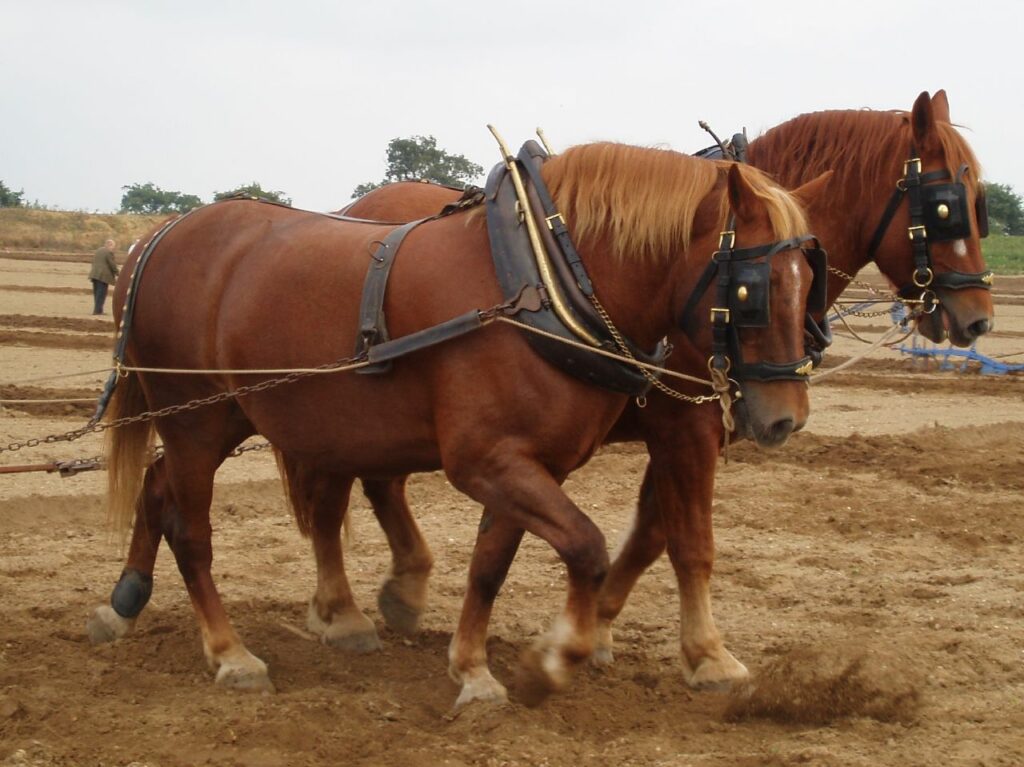
Photo: “File:Suffolk horses ploughing.jpg” by Amanda Slater from Coventry, England is licensed under CC BY-SA 2.0.
Soviet Heavy Draft
Height: 15,3- 16,3 hands (155-170 cm)
Weight: 1875 to 2200 lb (850 kg and sometimes reaches 1000 kg)
The Soviet cold blood was developed in the Soviet Union in the late 19th century and is closely related to the Russian cold blood. However, the Soviet cold blood is larger and heavier with its massive size. Derived from imported Ardennes, Brabant, and Percheron horses. Robust and powerful but with a rather lively temperament. The breed is used in agriculture and forestry.
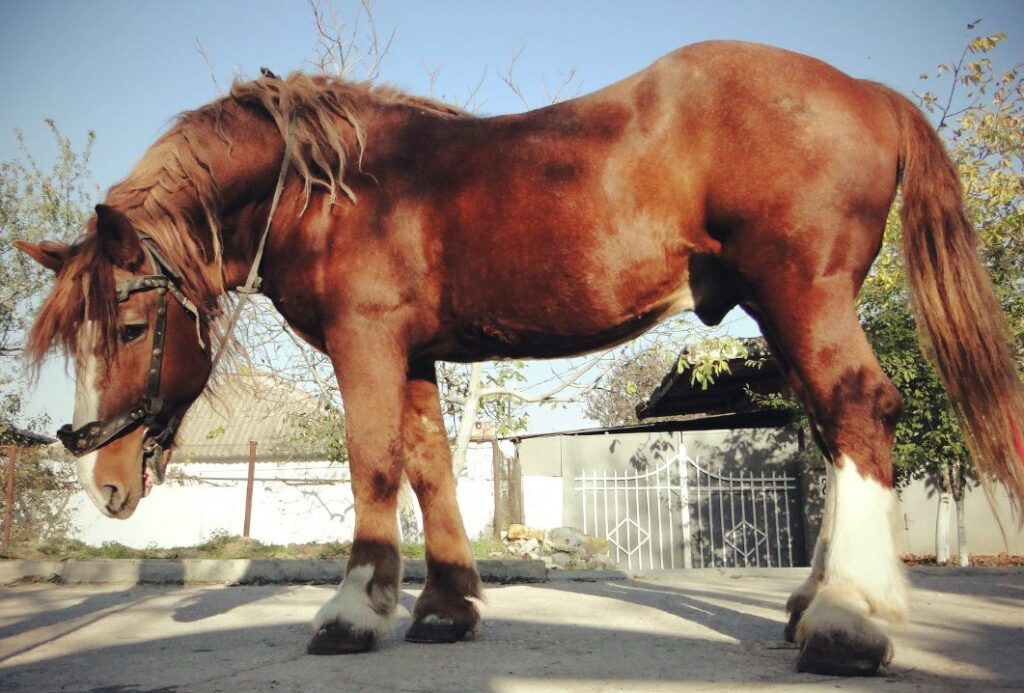
Photo: “File:Soviet heavy draft.jpg” by Iskulikov is licensed under CC BY-SA 3.0.
American Cream Draft Horse
Height: 15-16.3 hands
Weight: 1600 to 2000 lbs
The only draft horse native to the United States, existing since the early 1900s. The ancestor is the horse “Old Granny” from Iowa around the 20th century who inherited the Cream color through the Champagne gene, pink skin, and amber-colored eyes. They are like other draft horses known for their calm demeanor. According to the breed standard for American Cream Draft, the horse’s color should be light, medium, or dark cream on pink skin. The horse should have a long white mane and tail and amber- or hazel-colored eyes. The breed is quite rare and has only fewer than 400 horses registered in the U.S.
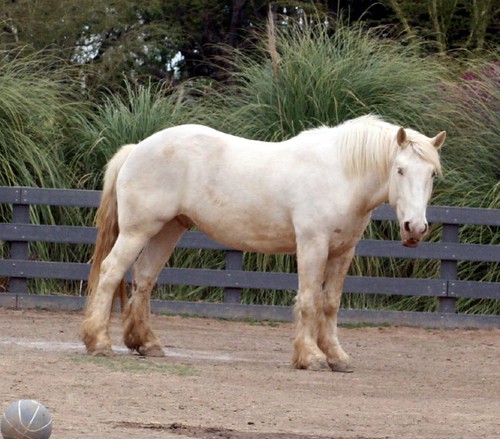
Photo: “American Cream Draft Horse” by Just chaos is licensed under CC BY 2.0.
Međimurje Horse
Height: 15.1-16.1 hands (155 cm 61 in to 165 cm 65 in)
Weight: Stallions can weigh up to 2000 pounds (900 kilograms)
Horse breed originating from Medimurje in the north of Croatia (formerly part of Hungary), developed in the late 18th/early 19th century by crossing Croatian mares with Anglo-Arabian characteristics with heavily imported stallions of the Noriker, Ardennes, Percheron, and Brabant breeds. Bay and brown are the two main colors that exist within the breed, other colors are rare. Formerly used extensively in agriculture and forestry but is now used mainly for meat production. Today only a few individuals (about 40) remain and the breed is endangered.
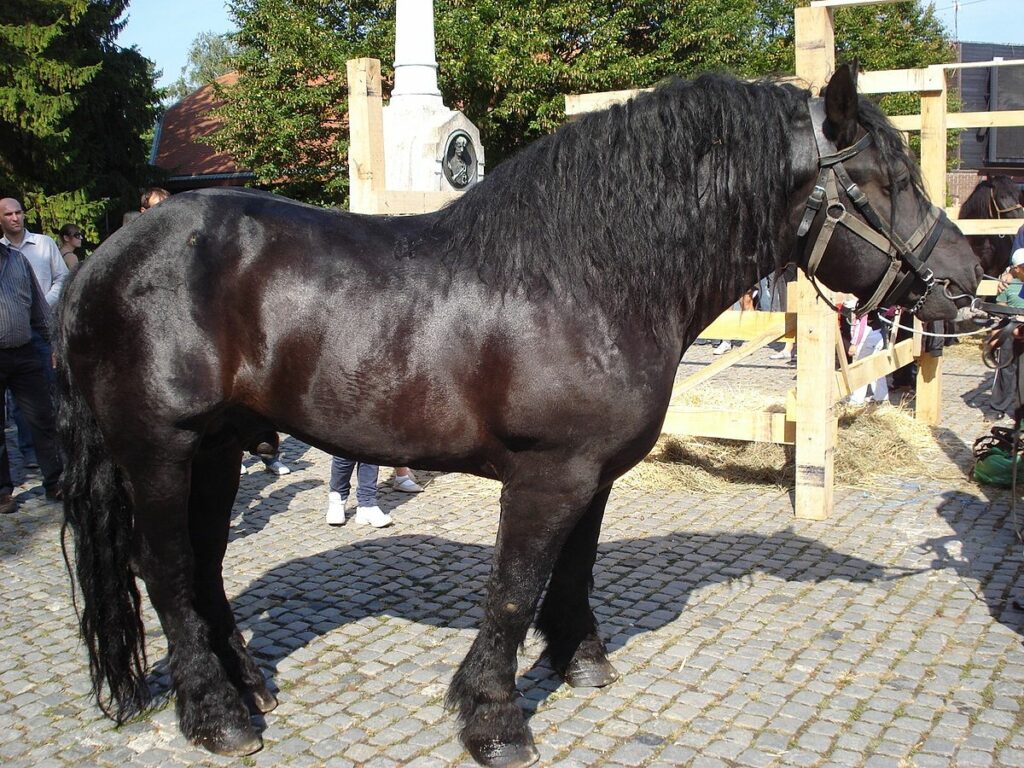
Photo: Silverije, CC BY-SA 3.0 https://creativecommons.org/licenses/by-sa/3.0, via Wikimedia Commons
Ardennes
Height: Stallion 16 hands Mares 15,3 hands (stallion 1.62 meters mares about 1.60 meters, minimum 152 cm)
Weight: 1500-2200 pounds (700 – 1,000 kilograms)
The Ardennes is the oldest draught horse in Europe and was mentioned in ancient times by Julius Caesar, among others. The breed originates from the Ardennes forest region located in Belgium, Luxembourg, and France. The breed was developed and played a major role during the First World War. The horse breed first arrived in the United States in the early 1900s. Today the horse is used as a draft horse, in agriculture, and driving competitions. The breed is also used for meat production. The most common colors of Ardennes horses are bay and roan, but chestnut, grey, and palomino also occur. Black horses are not allowed to be registered.
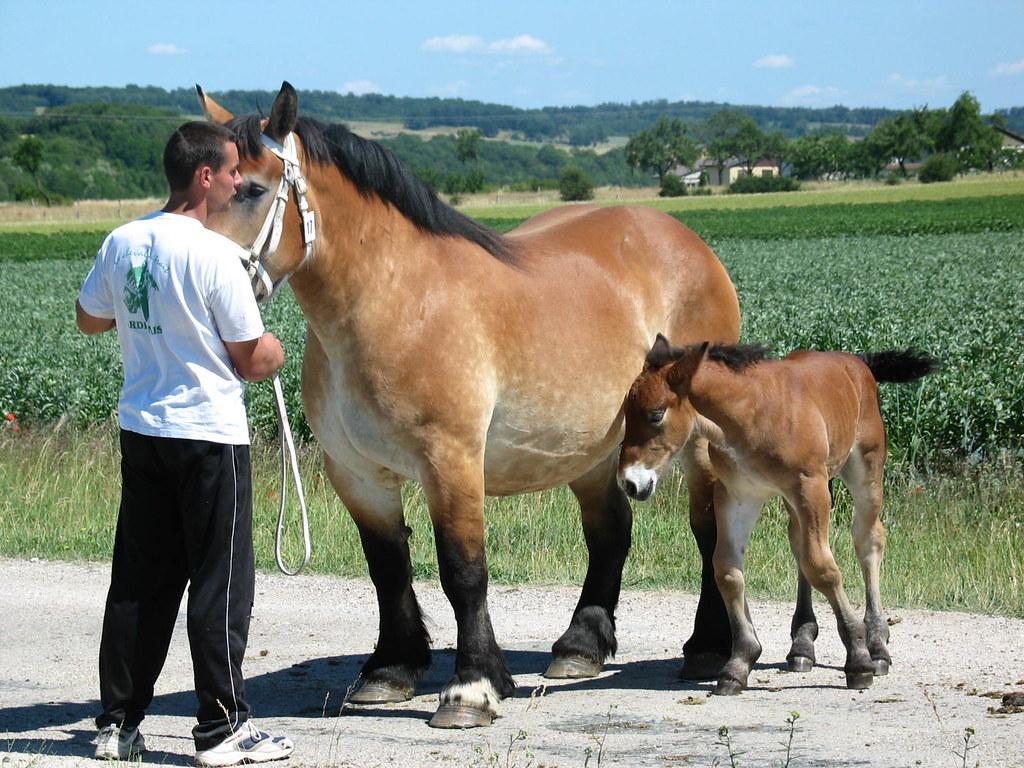
Photo: “concours cheval de trait Ardennais (POUSSAY,FR88)” by jean-louis zimmermann is licensed under CC BY 2.0.
There are subgroups within the breed that have almost become a breed of their own:
- Swedish Ardennes
- Baltic Ardennes
Breton Horse
Height: 15.1 to 16.0 hands (1.55 to 1.63 m)
Weight: 1990 lb – 2095 lb (900–950 kg)
Breton horses originate from Brittany in the northwest of France. Bred for use in the military but also for meat production. The studbook for the breed was started in 1909. There are two types of Breton horses:
- Postier Breton – slightly more agile and lighter draft horse
- Trait Breton – heavier with short legs and more suitable for agricultural work.
The color is usually chestnut.
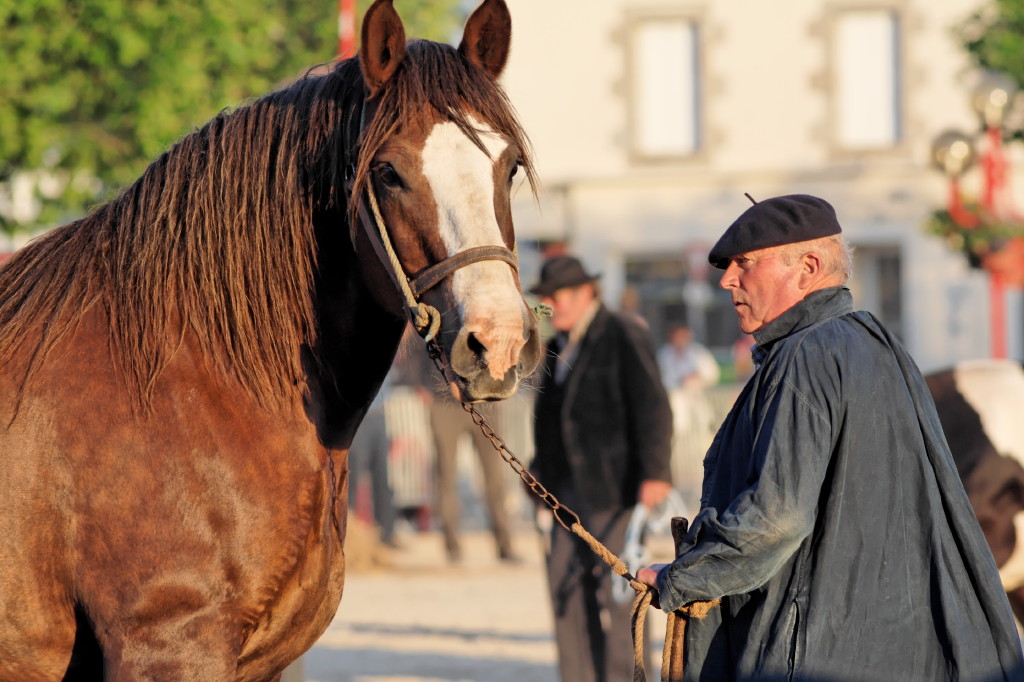
Photo: “File:Horse trait breton 5622.jpg” by Daniel Vaulot is licensed under CC BY-SA 2.5.
Lithuanian Heavy Draught
Height: 15 to 16 hands
Weight: 1875 to 2028 lb (850 to 920) kg
The breed was founded at the end of the 20th century by crossing different heavy breeds. Initially, they were registered as Ardennes crosses but in 1951 they were given their own studbook. Traditionally used as a draft horse in agriculture but more recently also used in meat production. The number of horses has decreased drastically and is now below 1000 individuals. The breed may have the following colors: bay, chestnut, black, grey, or roan.

Photo: “File:Lithuanian Heavy Draught 2.jpg” by Tocekas is licensed under CC BY-SA 3.0.
Schleswig Coldblood
Height: 15,1 – 16 hands (154 – 162 cm)
Weight: 1800 lb
Medium-sized draft horse originating from northern Germany. The breed originated in the late 19th century with the influence of the Jutland horse. Formerly used for agriculture work and in the timber industry, but has now declined in numbers and is threatened with extinction.
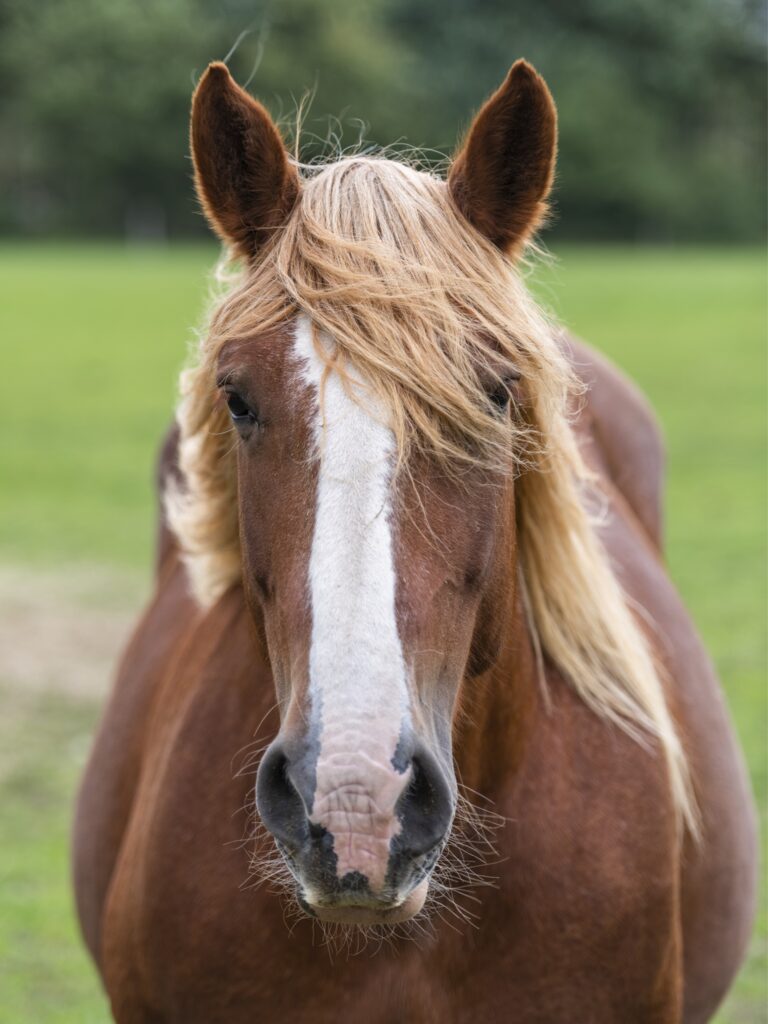
Photo: “File:Schleswig Coldblood (Ipernity-47394846).JPG” by Siebbi is licensed under CC BY-SA 3.0.
Dutch Draft Horse
Weight: 1 653 pounds (750 kg)
Height: 15,3 hands (1,60 m)
The Dutch Draft Horse is characterized by strength and commitment. Descended from the old native horse, the “Great Horse”, that existed in the Middle Ages on the West European coast from Denmark to France. Today, the draft horse is mainly used for breeding, recreation, and basic dressage work. One type of competition, the Power Horse Competition, has become popular, where draft horses compete with a focus on power, maneuverability, and speed.

Photo: “Dutch Draft Horse Team” by amandabhslater is licensed under CC BY-SA 2.0.
Jutland Horse
Height 14,3-15,3 hands (ca 150-160 cm)
Weight 1540-2200 pounds (700-1.000 kg)
Danish old horse breed whose studbook was established in 1881. A medium-weight draft horse is used mainly in agriculture. Today it is used as a leisure horse. The Jutland horse is often chestnut with a light mane and tail, but bay or black horses also occur within the breed.
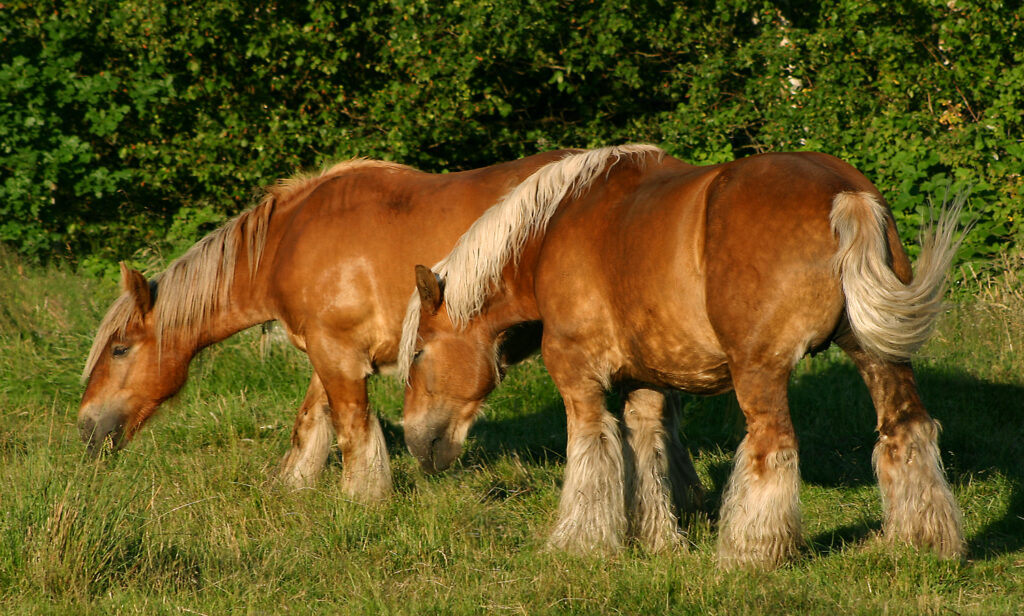
Photo: “File:Jydske heste vorup enge.jpg” by Malene Thyssen is licensed under CC BY-SA 3.0.
Rhenish German Coldblood
Height: 15,3 159 cm
Weight: 1860 to 2200 pounds
Breed from northern Germany that has been used as a working horse in forestry and agriculture as well as a draft horse. The origin of the breed is a cross between Belgian draft horses and Ardennes horses. Rhenish German Coldblood became a breed in its own right around 1850. Common colors within the breed are bay, chestnut, black, and grey. Today there are about 1100 Renish German Coldblood horses registered.
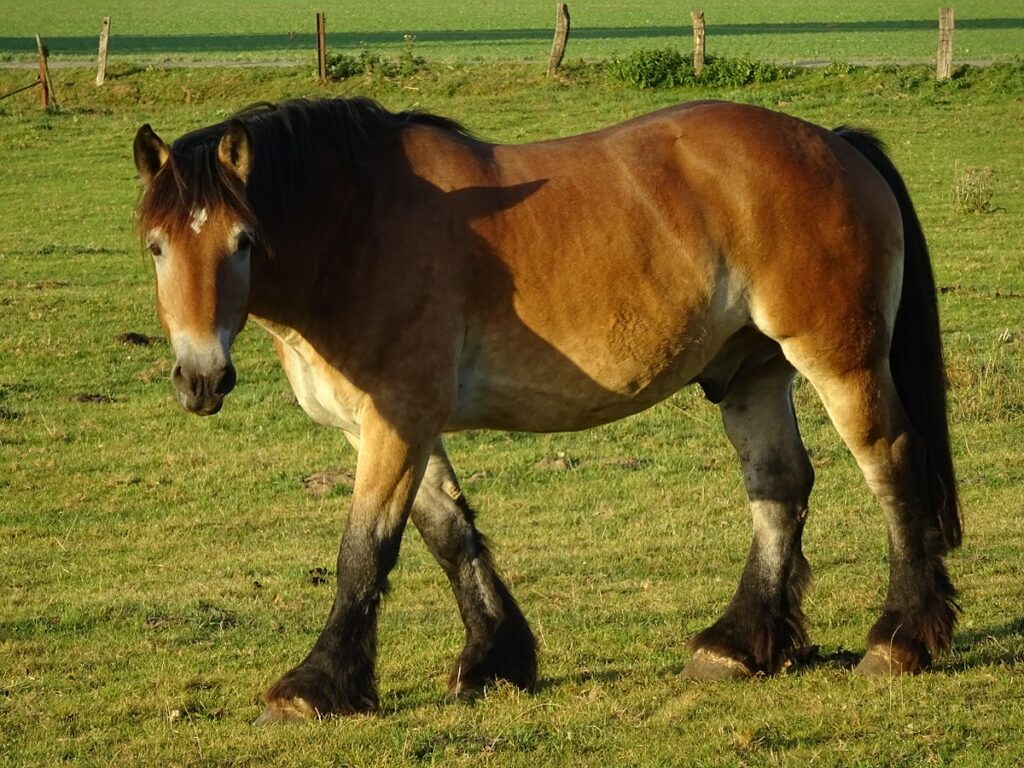
Photo: Pieter Delicaat, CC BY-SA 4.0 https://creativecommons.org/licenses/by-sa/4.0, via Wikimedia Commons
The Italian Heavy Draft
Height: 14.2 – 15.3 hands (58 and 63 inches, 147 and 160 cm)
Weight: 1320 – 1540 pounds (600 and 700 kg)
Breed from Italy, usually chestnut-colored with a flaxen mane and tail. Is similar to Breton who influenced much in the development of the Italian heavy draft. Originated in 1860 and has been used in agriculture and the military where it was known for its combination of strength and speed. The Studbook was established in 1926 and the breed increased until World War II and then drastically decreased. Today, the main breeding objective is to breed a horse suitable for meat production.
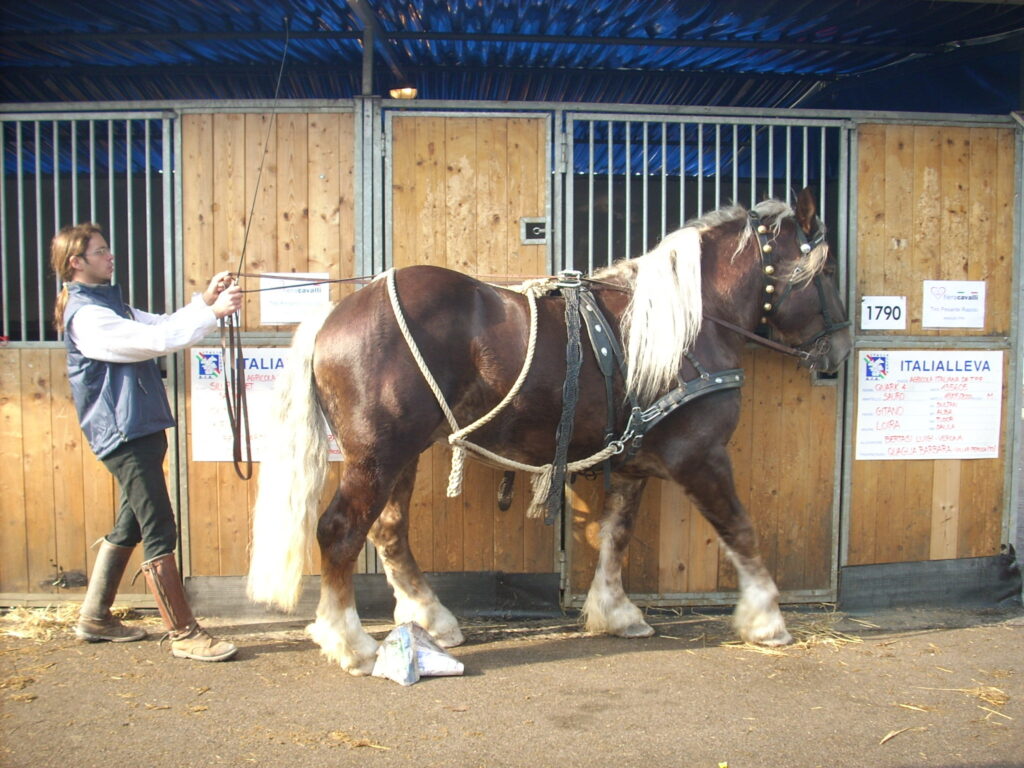
Photo: “File:Rocon 2007.jpg” by Annalisa Parisi is licensed under CC BY 3.0.
North Swedish Horse
Height: 15,1-15,2 hands (153-155 cm)
Weight: 1100-1540 pounds (5-700 kg)
The breed received its official name, North Swedish Horse (Nordsvensk häst) in 1900, derived from the Norwegian Dole stallions and the Swedish old breed of farmers horse. Today it is used as an all-round driving horse, for work and leisure, but also as a riding horse. Permitted colors are bay, brown, black, chestnut, buckskin, dark buckskin, smokey black, palomino, and dun colors.
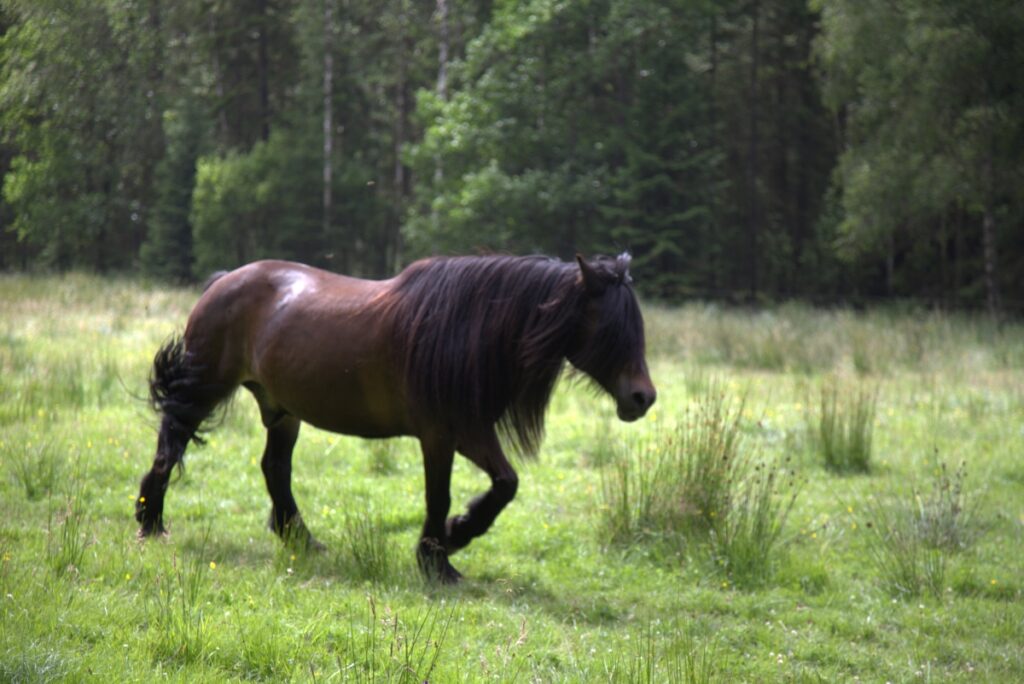
Photo: “File:Nordsvensk häst i Äggdalen 2015 002.jpg” by Averater is licensed under CC BY 3.0.
Comtois Horse
Height: 14.1 – 15.1 hands
Weight: 1430–1760 pounds (650–800 kg)
The Comtois is a very old French breed that dates back to the 4th century, one of the oldest breeds in the world. Used in the 16th century as a cavalry and artillery horse by both Louis XIV and Napoleon. Now bred mainly in the mountainous areas of the Massif Central, the Pyrenees, and the Alps. Still used today to transport timber in pine forests along the slopes, for work in the vineyards, and meat production. Today it is France’s second most common draft horse breed (Breton is the most common). They are chestnut colored with lighter mane and tail (flaxen colored).
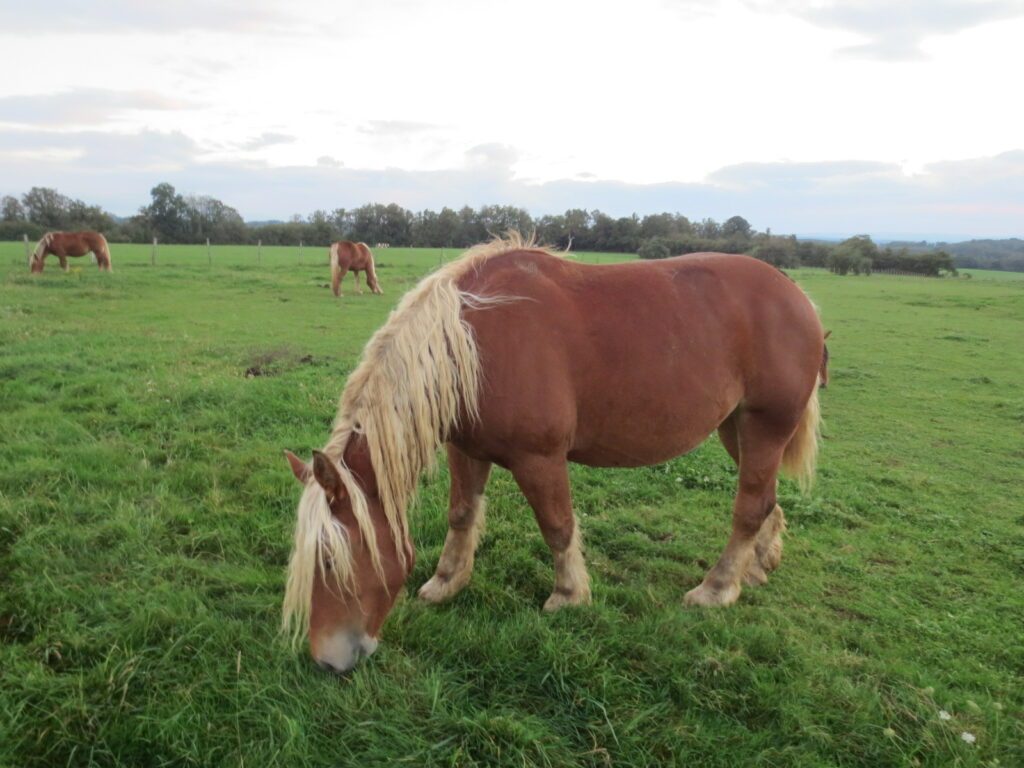
Photo: “File:Cheval Comtois 024.JPG” by Arnaud 25 is licensed under CC BY-SA 3.0.
Russian Heavy Draft Horse
Height: 15 hands (average 150 centimeters)
Weight: 1300-1550 pounds (580–700 kg)
The Russian draft horse began its development, influenced in particular by the Belgian Ardennes, at the end of the 19th century. They were first called Russian Ardennes but the Russian draft horse officially became a breed of its own in 1952 and is still used to some extent in agriculture as a draught horse. The Russian Heavy Draft Horse is known for its ability to pull a lot in relation to its weight. But is also known for its milk-producing ability. The milk is fermented (called Kumys in Russian) and the russians have been drinking this since the 19th century as a health-promoting beverage.

Photo: Unknown author, Public domain, via Wikimedia Commons
I hope this article was helpful to you and that you now know all about the largest horse breeds in the world!
Sources
https://www.belgiancorp.com/ The Belgian Draft Horse Corporation of America
https://www.kvth.nl/Home.aspx
https://clydesdalehorsesociety.com/
https://www.percheronhorse.org/
https://www.suffolkpunch.com/
https://suffolkhorsesociety.org.uk/
https://www.le-boulonnais.com/ American Boulonnais Horse Association
https://acdha.org/
https://shirehorse.org/
https://www.shire-horse.org.uk/ Shire Horse Society
https://imh.org/exhibits/past/breeds-of-the-world/europe/russian-heavy-draft/
http://www.cheval-ardennais.fr/
https://www.guinnessworldrecords.com/
https://www.gip-cheval-breton.fr/en/breton-horse/
https://www.sunkiejiarkliai.lt/
https://denjydskehest.dk/
https://nordsvensken.org/
https://www.g-e-h.de/
http://www.schleswiger-kaltblut.de/

